#xiapei
Explore tagged Tumblr posts
Note
Hello this might be a silly question but I genuinely wonder if the Pi Bo and Pi Feng can be worn together?
Hi! Thanks for the question, and sorry for taking ages to reply!
Historically, 披帛/pibo and 披风/pifeng would not have been worn together, as they are from different time periods.
As I explained in my post on pibo here, the pibo - a scarf-like accessory - first appeared sometime around the Qin dynasty, really came into vogue during the Sui & Tang dynasties, and fell out of common use during the Song dynasty. Below - Tang dynasty-style pibo (via):
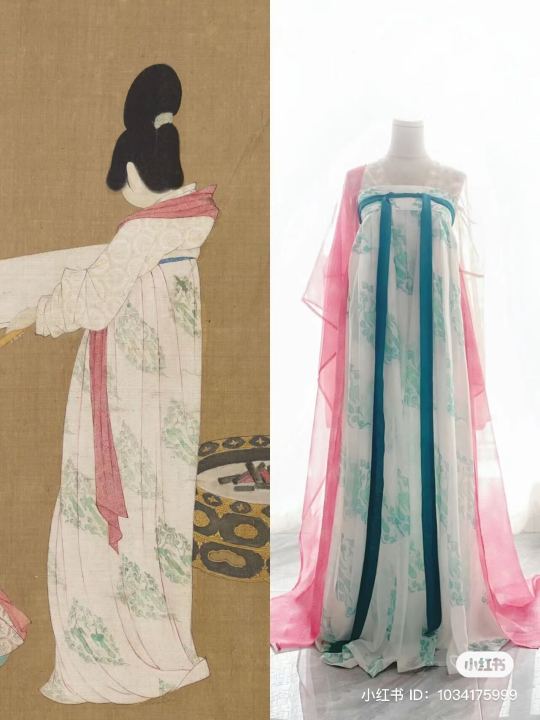
The pibo didn't disappear, though - it just evolved. During the Song dynasty, the pibo evolved into the 霞帔/xiapei. The xiapei became an important component of women's formal attire in the Song, Ming, and Qing dynasties (x). Below - xiapei in Ming dynasty portrait (via):
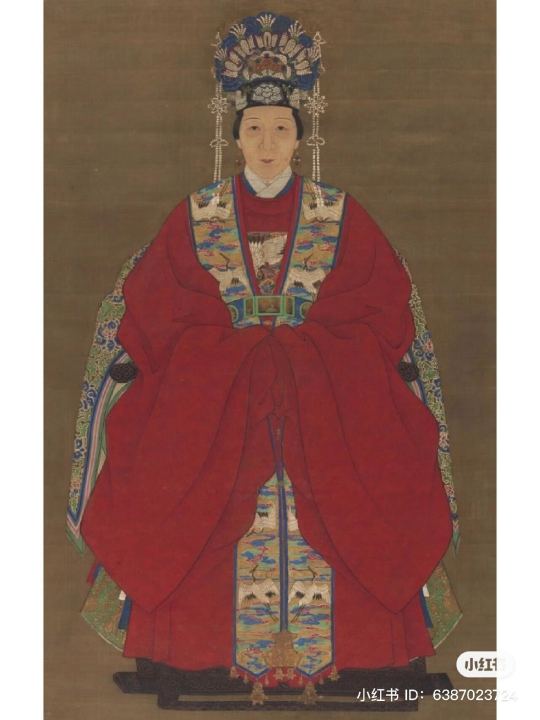
Meanwhile, the pifeng, an outer coat with loose and long sleeves, was worn during the Ming dynasty (pifeng is the Ming dynasty name for beizi). Below - pifeng (via):
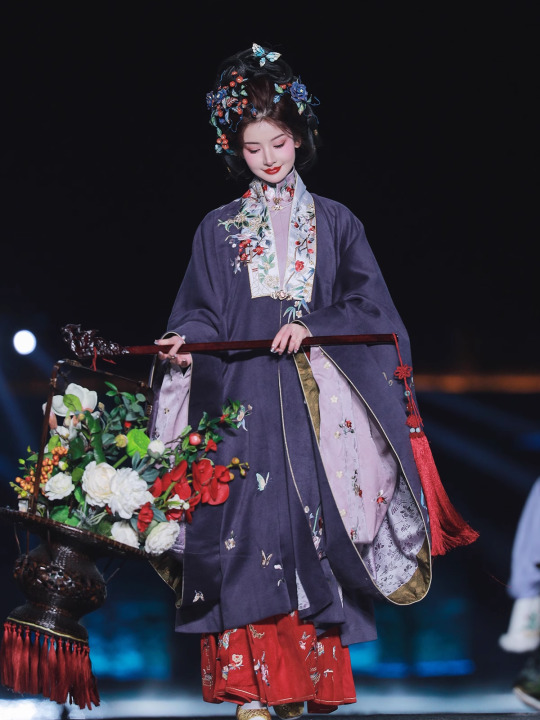
So technically, it would be anachronistic to wear the pibo and pifeng together. However, nowadays people are free to mix and match hanfu as they please. Unless you're going for historical accuracy, there's no reason not to wear the pibo and pifeng together if that's what you want ^^
Hope this helps!
#hanfu#pibo#pifeng#xiapei#mix and match#history#ask#reply#reference#>100#chinese fashion#chinese clothing#china
120 notes
·
View notes
Photo
NICE






chinese hanfu by 不是小晶
492 notes
·
View notes
Text






Chinese dramas x Chinese history
It’s very common to see C-dramas take inspiration from actual historical paintings and artifacts from different dynasties. With some dramas adding a modern twist to them.
#china#chinese heritage#chinese culture#chinese#🇨🇳#han chinese#Hanfu#Chinese clothing#people’s republic of china#sino#dynastic China#imperial China#Clothing#Middle kingdom#Chinese artifacts#restoration#phoenix crown#diyi#fengguan xiapei#fengguan#China’s culture#China’s history#China’s heritage#Tang Dynasty#Ming dynasty#song dynasty#Tang#Ming#Song#chinese history
156 notes
·
View notes
Note
What dynasty are wuxia hanfu based off? The ones in The Untamed and Word Of Honor look cool but I can't tell which dynasty they're based off
It depends on the story/show :D
Wuxia shows can be from any dynasty, or even no dynasty at all. There's a Chinese term called "架空" (jiakong), essentially it means the story takes place in a fictional time period that doesn't actually exist in history. Stories that are "jiakong" have a lot of leeway when it comes to clothing, hair, settings, etc. because the writer/director can essentially do whatever they want.
Xianxia stories (like The Untamed) tend to be "jiakong" because immortals don't actually exist. To put Xianxia stories into actual history, the writer would have to make a lot of changes to what actually happened in history, which can get messy, so most writers choose to "jiakong" the time period just to make things easier.
Wuxia stories (like Word of Honor) can be "jiakong" or set in a particular dynasty. In the case of Word of Honor, it's "jiakong".
Because of that, the Hanfu designs for both shows are a mixed batch. I don't think the costume designers had any dynasty in mind when designing these clothes and instead just went with a basic "look" of Hanfu (long sleeves, long robes) and worked from there.
(If I get any of the characters' names wrong, please forgive me, it's been a while since I saw these shows OTL)
For example, in the pic below this style of flipped out collar worn by A-Xu doesn't fit with any Hanfu styles I'm aware of. The only flipped-out collar I know of is sometimes when wearing quju robes (pic 2,3) of the Qin/Han Dynasties, and he's definitely not wearing a quju.
【EDIT】 The collar of Tang Dynasty robes could be worn flipped outwards to reveal the semi-sleeve inside, but that's not the style A-Xu is wearing here.
Also the long slits in the bottom of the robes they're wearing, some Hanfu styles from the Tang Dynasty and onward do have slits but they were one on either side, and possibly one at the back, more commonly seen with round-collared robes (though not always).



Here Wen Kexing has on a quling (turtle-neck collared) undershirt which is seen in Han/Weijin Dynasties, but then the white robe has a flipped out collar. A-Xu's entire outfit is...lol, I think he's purposely wearing his collar loose like that to portray that he didn't really care about his appearance but technically no collar should be so low as that light-blue robe he's wearing. I don't think that robe actually has a defined collar, the fabric is just loosely gathered but there's no collar "cuff".

In this pic, Wen Kexing has a round collared robe which is seen in Tang, Song, Ming, but then the sleeve is like a half-shoulder vest rather than full sleeve, and that's also not seen in any Hanfu styles.
...Or is that one robe? Is the sleeve connected to that shoulder piece? Because it looks like the robe he has underneath is red (from the collar). I can't tell, but either way, that shoulder design is not a style found in any Hanfu of a particular dynasty.

This couple's wedding outfit is influenced by a mix of Song and Ming Dynasty. She's wearing green, usually seen in Song Dynasty, but her collar is a criss-crossed collar which would be Ming (Song would be like pic 3 where the woman is wearing a low-collared top rather than a high-collared robe). She's missing the "xiapei (霞帔)" which is that strip of fabric draped on the shoulders (pic 4), but it looks like the costume designer put a strip of red along the collar to give an illusion of wearing xiapei.
For the groom, rather than the official round-collar robe he's wearing a cross-collared robe, and his red is more of a blue-ish tint. Usually wedding robes, if red, are a bright red (literally called "China red" in China, xDD).




For this pic below, it's a 1-piece robe with collar piece going across the chest, then straight down from the waist. It could be a Tang or Song style Hanfu, but the sleeves, the belt, and the overall fit of the clothing isn't quite right.
The Untamed made a lot of their clothes really form-fitting against the actors, that's actually not a good fit for Hanfu in general. You want a nice loose fit, even if the clothing is "form-fitting" it's not meant to stick to your frame. Because of this, the clothing in the Untamed always appear a size or two too small (Word of Honor did a better job of sizing their clothes). If they were wearing today's clothing then it's no problem, but for Hanfu it's too tight >_< Then again, that's probably just the style they were going for so ¯\_(ツ)_/¯

This black jacket/vest definitely was just created for a "cool" aesthetic. Xianxia/Wuxia shows love doing this broad shoulder vest garment, in actual Hanfu there ARE garments that look similar but these shows really run with it.

Here, Jinguang Yao (it's Yao, right?) is wearing a round-collared robe which was popular in Tang, Song, and Ming. The outer jacket and the material (it looks like brocade rather than soft silk) makes me lean towards Ming Dynasty for this outfit.
It also has an emblem piece on the chest which makes me think of the Mandarin Square robe during the Ming Dynasty (work attire for court officials) except: 1) Mandarin squares are embroidered separately then sewn onto the robe, this looks like it was weaved into the fabric 2) Mandarin Square robes in Ming Dynast were red 3) This emblem is round instead of square
So I would say they took inspiration from the Mandarin Square robe but changed aspects to make it fit into the show better (I think the show kept most characters in lighter colours to contrast with Wei Wuxian's darker, bold colours).


There's also things like the buildings, props, etc. to consider if we were to really dig into dynasties. And the hair styles, that half-up half-down thing is purely for aesthetics because in history they wouldn't wear their hair like that (especially considering their background).
There was a short period during the Jin/North-South dynasty when some men did wear half their hair down, but that was ONLY because that period of time was notoriously chaotic and the "rules" specifying appropriate behaviour in society had crashed (礼崩乐坏). Essentially, if you were a "civil" man (particularly with some education from a wealthy family) all your hair is tied up at 15 yo, and at 20 you get your guan (hair piece) ceremony symbolizing you're now an adult.
For women, pre-marriage you can leave some hair down, but tied in the back, not loose. After marriage it all gets tied up.
Leaving hair loose would basically get you labeled as rude, disrespectful, uncouth, uneducated, crazy, you get the idea.
But in shows like this it's a nice aesthetic when they're doing martial arts moves and the hair is flying around, so these days it tends to be the go-to hairstyle for xianxia/wuxia shows.
I hope that was helpful :D None of this is to say these costumes aren't beautiful, just not history textbook Hanfu ^^;;;;
#hanfu#汉服#china#中国#chinese hanfu#culture#history#fashion#clothing#historical clothing#the untamed#word of honor#陈情令#山河令#古装电视剧
392 notes
·
View notes
Text
April 20, Beijing, China, National Museum of China/中国国家博物馆 (Part 4 – Chinese Historical Fashion Exhibition continued):
Alrighty, Ming and Qing dynasty fashion, here we go! Sit tight because this is an extra long post that took me a long time to research
First is this marvel, a replica of the phoenix crown/fengguan/凤冠 of Empress Xiaoduanxian of Ming (明孝端显皇后). The real artifact is in this museum, but it's probably not exhibited much for conservation reasons.

Phoenix crowns are the formal headwear for empresses, which according to etiquette rules set at the beginning of Ming dynasty (1368 - 1644), must have 9 dragons and 4 phoenixes (btw the original Chinese term is fenghuang/凤凰, which is a different mythological creature from the phoenix, but "phoenix" is the commonly used translation now), but this crown has 9 dragons and 9 phoenixes, indicating that etiquette rules have loosened and shifted by late Ming.
The phoenixes on this crown are blue because they were actually made with the iridescent feathers of kingfishers in a process called diancui/点翠. All species of kingfishers are now legally protected animals in China, so when buying hanfu accessories, you may come across "imitation diancui"/仿点翠, these are usually either made with enamel or dyed chicken or goose feathers. Another thing to note is the appearance of the jewels on this crown. Ming-era people liked keeping the jewels in a "natural look", so these jewels had no facets.

Recreations of Ming-era hanfu. Left is the semi-formal outfit of aristocrat women in mid to late Ming dynasty. Right is the casual outfit of late Ming scholars and literati. The woman's cone-shaped hairstyle is called a diji/䯼髻, and the set of hairpins that goes on a diji is called toumian/头面. She's wearing a type of top called an ao/袄 and a skirt aka qun/裙, specifically a mamianqun/马面裙, or "horse face skirt". Note that the bottom hem of an ao is not tucked into the skirt. The man is wearing a square-ish hat called a fangjin/方巾 and should also be wearing a wangjin/网巾 underneath (can be understood as a hairnet). He's wearing a daopao/道袍 and a hechang/鹤氅 on the outside.

Also I did make a mistake while dividing up the pictures for these two posts, some of the following artifacts are from earlier dynasties. Ugh if only I had time to take pictures of all the placards.
A pair of mojie/摩竭 shaped gold earrings from Liao dynasty (916 - 1125). Note that the placard says it's "摩羯形" or "Capricorn-shaped", but this apparently is sort of a misnomer? Sort of, because this representation should be of the makara (मकर; translated as 摩竭 in Chinese), a sea creature from Hindu mythology, but at the same time it is the equivalent of Capricorn in Hindu astrology. However since the name "Capricorn" stuck, it's now commonly referred to as "摩羯". 摩竭 and 摩羯 have the exact same pronunciation though.

A pair of phoenix (fenghuang) shaped gold hairpins from Liao dynasty:

After a lot of pulling my hair out researching, I finally found what time period this gold belt buckle came from. It's from Eastern Han dynasty (25 - 220 AD). The gold filigree and beads form the pattern known as panchiwen/蟠螭纹, where pan/蟠 and chi/螭 are both types of loong dragon in Chinese mythology.

The gold decoration on a xiapei/霞帔 (the V-shaped wide band in the diagram on the right) from Liao dynasty. Xiapei originated in Song dynasty (960 - 1279) as part of the formal attire of consorts, but later developed into a part of the formal attire for women in general. Xiapei also looked different at different time periods in history, but from Song-era to Ming-era, its structure didn't change by much.


Finally back to Ming dynasty. This is a gold cap inlaid with gems and pearls. From the size of this cap and the included hairpins, we can deduce that this cap is meant to encase the bun on the top of the head (the hairpins that go through the cap would hold it in place).

Like the gold cap above, the next few are all from the same tomb of a Ming dynasty noble, and they are all themed similarly--they all depict scenes in a heavenly palace. Of these, the first three that has miniature architecture in gold are parts of the toumian worn on a diji hairstyle. This first one is a pair of yanbin/掩鬓 (lit. "covering temples"), so called because they are worn on the sides, close to the temples.

This next one has some confusion regarding the naming. According to an article by the Chinese Academy of Social Sciences Institute of Archaeology, the top artifact is a fenxin/分心 and the bottom artifact is a tiaoxin/挑心, but according to 撷芳主人 (if you are a hanfu enthusiast you have probably heard of this person or seen their works, they are the one who drew the cute illustrations of Ming-era fashion), the top one may be a manguan/满冠, and the bottom one should be called fenxin/分心. Note that 撷芳主人's conclusion is mostly based on Ming-era records and novels. Regardless of the naming, the top one here should be worn on the base of the diji, and the bottom one should be worn at the front center of the diji.

This one also has some confusion in the naming, the Institute of Archaeology calls it a dingzan/顶簪, while 撷芳主人 calls it a tiaoxin/挑心. Again, regardless of the naming, this one is worn on the very top of the diji, so the hairstick portion goes straight down through the diji. If you look closely, you can even see people and animals in the details.

Left: a pair of gold phoenix (fenghuang) hairpins made in the 22nd year of the Yongle Emperor of Ming. Right: gold filigree bracelets inlaid with gemstones.


Ming-era portrait of a scholar official. Before cameras were introduced in late-Qing dynasty, portrait paintings were the most realistic depictions of what people looked like back then. Such portrait paintings mostly began in Song dynasty and continued through to Qing dynasty.

Illustrations of the different buzi/补子 (also known as "mandarin square") used by different ranks of officials in Ming dynasty. All ranks are organized from highest on the left to lowest on the right, top row is for civil officials, bottom row is for military officials, and bottom right is for nobility. All illustrations here come from the Ming-era illustrated encyclopedia Sancai Tuhui (《三才图会》). For those who are interested, a scan of Sancai Tuhui is available on Internet Archive for free (link goes to first chapter, most chapters are available).

Also from Sancai Tuhui Chapter 62 (all pictures here come from Ch. 62-64), illustrations of the twelve ornaments (called shierzhang/十二章) on a mianfu/冕服, which is the highest level of formal attire for an emperor in Ming dynasty. These twelve ornaments depict things including celestial bodies (note that sun contains the three-footed sun crow, and moon contains the moon rabbit), elements of nature, mythical creatures, and representations of life, and are supposed to represent the values and traits that an emperor should possess:

And wrapping up the section on Ming-era hanfu, here are the headwear of different classes of people in Ming dynasty, from commoners to the literati to important government officials.
Note the net-like hair accessory on the left. This is a wangjin/网巾 during Ming dynasty (illustration from Sancai Tuhui), and is worn by all men regardless of social class. However, wangjin is worn almost like an "undergarment", so it's almost always covered by something else. Which means all those historical cdramas set in Ming dynasty that have their characters wear only a wangjin in public are, in fact, inaccurate.

Some hats of commoners and scholars in Ming dynasty. Note the left one on the second row, that is the same hat worn by the Fox Scholar in the episode Goose Mountain of the animated series Yao Chinese Folktales (《中国奇谭》).

Some of the formal headwear of government officials in Ming dynasty. These are called liangguan/梁冠, lit. "beam crown", where the liang/"beam" refers to the metal arches that go over the top. The more liang there are on the hat, the higher the rank of the official.

And last but not least, Qing dynasty (1616 - 1911) fashion. Left is Qing-era men's outfit for horseback archery and hunting, called xingfu/行服. His hat is composed of two parts, the actual hat called dingdai/顶戴 (here it's specifically the winter version) and the back decoration made of horsehair and feathers that signifies status is called hualing/花翎. Back is the casual outfit of late-Qing Manchu noblewomen, with the characteristic hairstyle called dalachi/大拉翅, a vest called kanjian/坎肩, and a robe beneath called chenyi/衬衣. These are all considered part of qizhuang/旗装, or traditional Manchu clothing. On the right is the late-Qing casual outfit of upper class Han women, with an ao/袄 top and a langanqun/阑干裙 skirt (a type of mamianqun/马面裙), and a headband decorated with pearls called mo'e/抹额. Note that although the exact origin of the modern qipao/旗袍 is disputed, it definitely has elements from at least one of the following: the Manchu chenyi, the Han ao, and the late Qing and early Republic era men's changshan/长衫.

A little historical background on why this particular display is arranged in this way. In early Qing dynasty, the Manchu ruling class enforced the policy of 剃发易服 (lit. "shaving hair and changing clothing") specifically on Han men in order to force conformity to Manchu traditions in terms of hairstyle and clothing, but Han women were not included in this policy. So in early Qing, Han women still wore the same clothing as they did prior in late Ming, but over the time the fashion of Han women absorbed many elements of Manchu fashion. However, this wasn't a one-way influence. By late Qing, many elements of Han fashion were adopted by Manchu fashion as well, so this influence really went both ways. Today, Manchu people is one of the 56 officially recognized ethnicities in China (4th largest ethnicity by population), and the traditional fashion of Manchu people is a part of the diverse culture of modern China.
Below is a real example of a chenyi, chenyi were popular among Qing dynasty imperial consorts as informal dress:

The hairstyle of Manchu women (called qitou/旗头) at different times during Qing dynasty. The one at the far right was what early qitou looked like, while the one on the far left appeared in late-Qing. The two hairstyles on the left frequently appear in period dramas set in Qing dynasty.

A belt called jifudai/吉服带 with pouches and decorations. Jifudai is so named because it's supposed to be worn with the semi-formal jifu/吉服 outfit. This particular jifudai is yellow, a color reserved for the emperor.

Real examples of Qing-era Han women's outfit, with an ao on the left, and a langanqun on the right. Langanqun is a type of mamianqun, but the construction is different from Ming-era mamianqun, in that langanqun is made from numerous rectangular and trapezoidal pieces of fabric sewn together into two larger pieces, whereas Ming-era mamianqun are simply two large pleated pieces of fabric. The way these skirts are decorated are also somewhat different. Visually speaking, Qing-era langanqun have woven and/or embroidered patterns that are arranged vertically, creating a "paneled" look, whereas Ming-era mamianqun have woven and/or embroidered patterns that repeat and extend horizontally as to wrap around the entire skirt.

Aaaaand that's it for this exhibition! Phew. I highly recommend everyone go visit the free virtual exhibition (link here), partly because when I visited the National Museum of China, I was in a huge hurry (I only had one day to see everything), and so the task of taking pictures of the exhibition was split between me and a family member, but I'm not sure they understood how many pictures I wanted....so what's in my posts here are only a very small portion of the actual exhibition. The actual exhibition doesn't just have artifacts and replicas of artifacts, but also have paintings and real articles of clothing from Qing dynasty, which were all amazing to look at.
#2024 china#beijing#china#national museum of china#historical fashion#historical clothing#chinese historical fashion#hanfu#chinese hanfu#manchu fashion#fashion history#chinese history#chinese culture#history#culture
127 notes
·
View notes
Text
Chinese hanfu.




Ke Ying for 2024 National Style Ceremony
87 notes
·
View notes
Text
HIT THE SLAY BUTTON 🚨🚨
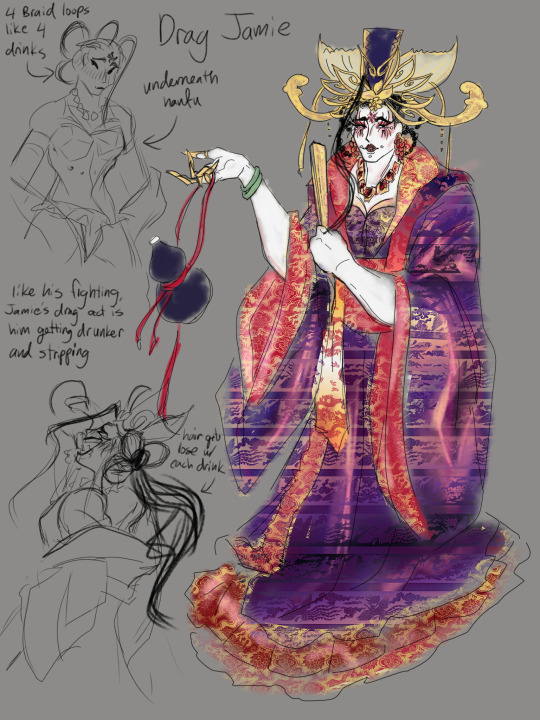


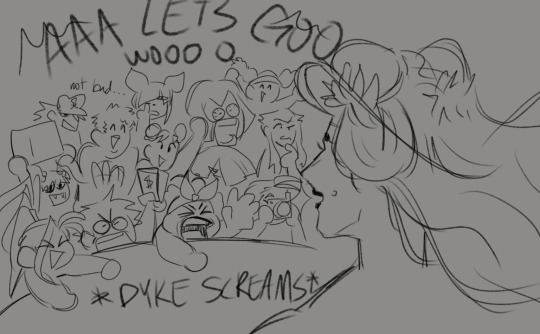
i was and am absolutely sick and floored that i couldn’t find a single drag queen jamie headcanon or design. i, frankly, absolutely despise designing things, especially fashion, so i grit my teeth and went into agony to deliver this concept.
seriously, how can you not look at this kid and go “a DRAAAG QUEEN???” anyways…here’s my design notes
if i’m referring to jamie in his drag persona, i’ll be using she/her pronouns as is customary with drag queens. and forgive me for any historical or chinese errors; i cannot read or write chinese i can only speak it, and my buddy vinnie stopped answering my questions after a while.
tentative drag name: xiao long bao—yun and yang are known as the white dragon (bai long) and blue dragon (lan long) respectively, but jamie’s title is a pun: “dragon” or “long” is the title, but the entire word “xiao long bao” jsut means soup dumpling. and that’s fitting to me as a nickname for jamie, but imo, it’s not a good drag name. it’s cute and it’s fitting, but it’s not vogue, it’s not a performance name. PLEASE GIVE ME IDEAS IM BEGGING YOU
jamie really seems to like having chinese inspirations in his normalwear, so it made sense to me to have his drag persona be very inspired by hanfu (i believe this is uhhh tang dynasty; the one focused on very ornate patterns with the cross-body robes and emphasis on a waistline; though normally every chinese character pulls from song-dynasty tradition). since i’m not very imaginative, this look was pulled straight from Guangzong drag queen Yuhua Hamasaki


in that traditional chinese hairstyle, jamie has 4 loops in the back with the crown and 4 major pieces of clothing, and with every swig, the loop gets untied and a piece of clothing gets taken off (numbered in order of taken off) the top of the clothes is a zhiju (2, 直裾), dark purple with a reddish iridescent pattern, with a the red xiapei (霞帔) scarf on top. it’s tied with a “horse face skirt”—mamianqun (1, 马面裙) —giving that very long dress/skirt sillohette. underneath that is a jinru (3, 晋襦), another cross-body but shorter robe that’s red and hides the typical drag queen bodysuit (4) that she can then breakdance in.
i debated the logistics of breakdancing in drag heels, but turns out elektra fence has done it on drag race before so. i don’t need to justify its plausibility.
the other two designs are kind of jokes; i’ve (against my will) been forced to see that darkstalkers felicia jamie mod, and i think it’d be a really cool if this actually was a drag thing of his, especially with my hc that yang kind of treats jamie like a beloved stray cat. and felicia’s a performer and singer; i’m sure he could do it. i did adapt some things from felicia’s design; instead of an actual tail (or even a prop one)—which could fuck up jamie’s breakdancing routine—she ties her hair at the end, where it’s dyed white to act as a “tail.” i also hope you enjoy the paw high heel concepts i came up with.
i like jttw, it’s probably my favorite legend of all time and i blame sun wukong for 40% of my personality. but quan yin is absolute fucking mother, and we must pay tribute, so like with his usual routine, jamie strips and reveals the lotus dress underneath her robes.
yun and yang are surprisingly supportive of jamie’s drag hobby, and they’re willing to participate in performances or just show up to support; hence, i think they open up the quan yin act with a fight between sun wukong (yun) and the liu er mihou (yang) before jamie comes in and breaks up the fight by distinguishing the two. the reason for yang’s pensive expression is that, because sun wukong and liu er mihou look exactly alike, then yang has to look like yun, something he despises. would require heavy convincing, but i think he’d eventually budge.
i think jamie’s drag attitude (and attitude in general) reminds me a lot of wesley snipes—an actor typically in hypermasculine action films, who played a very flamboyant drag queen. i’m referencing his role as noxemma jackson in “to wong foo” of course; everything about snipes as noxemma absolutely reeks of jamie, and i could see this being a major inspiration and influence for him
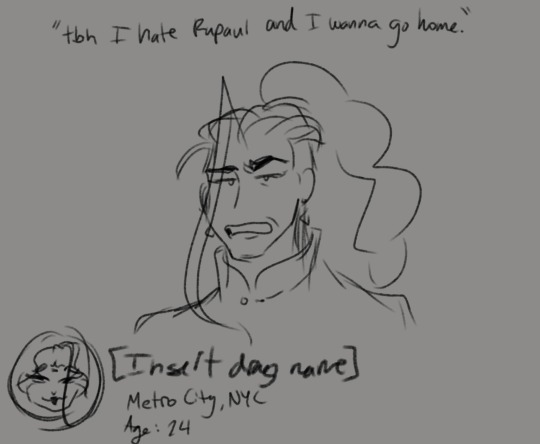
i thought a bit about jamie on rupaul’s drag race, and i concluded that he would fucking hate it. drag queens are viscous, and jamie’s good at quipping insults back, but he’s also used to being able to throw hands afterwards. i can imagine he’d say things like “even the most aggressive, dangerous street fighter cannot match the viciousness of these girls.” i also think he would not like rupaul because rupaul is racist and the judges don’t like cultural performances.
ah yes. the lesbian fucking love drag queens. drag in general—they show the fuck up. jamie in drag would summon every dyke with a 50 mile radius immediately, tips and drinks in hand to be given.
anyways, someone please tell me i’m not insane for this idea that is totally canon, peer reviewed, no notes.
#street fighter#street fighter 6#darkstalkers#sf6#third strike#jamie siu#yun lee#yang lee#drag race#drag queen#gay#my art#might draw luke’s reaction asp cause ive actually never drawn him yet
49 notes
·
View notes
Note


Ah I didn’t know you could add images to asks now! Idk how to describe, but you can see in these images how the shoulder pieces are popped up. I love how it looks but not sure if it’s historically accurate
The pop up shoulder piece is called xiapei and it works sort of like a sash for more formal wear. The version in the Serenade of Peaceful Joy still (left) is probably more historically accurate than combined with the standing collar in the Empress of China still.
7 notes
·
View notes
Text
Dream Journey 2 Princess Iron Fan (2017) 大梦西游2铁扇公主









Director: Tan Qiao Screenwriter: Tan Qiao / Zhang Yinli / Zhou Fengping Starring: Xie Miao / Huang Yilin / Li Xiapei / Jiu Kong / Ma Jingjing / Wu Yijiang / Zhao Tieying / Jin Yana / Xiao Yuewen / Mo Meilin / Youyi Genre: Drama / Action / Fantasy Country/Region of Production: Mainland China Language: Mandarin Chinese Date: 2017-01-30 (Mainland China) Duration: 91 minutes IMDb: tt9842404 Type: Reimganging
Summary:
Sun Wukong (played by Xie Miao) is entrusted by Guanyin to go back 500 years ago to get a tear from Princess Iron Fan (played by Huang Yilin) to restore the magic power of the banana fan. Unexpectedly, Sun Wukong lost his memory after returning to the past and became Princess Iron Fan's little follower. At that time, the banana fan was taken by the Bull Demon King (played by Ma Jingjing) and Jade-Faced Fox. Princess Iron Fan led Sun Wukong to fight with them many times, but all ended in failure. Sun Wukong was also seriously injured in the process. His courage and persistence gradually moved Princess Iron Fan's cold heart.
However, at this juncture, the Bull Demon King proposed to Princess Iron Fan. Sun Wukong knew that he was not as good as the Bull Demon King, so he left sadly and planned to pick an immortal flower as a wedding gift for the two of them. The magic power of the longevity flower allowed Sun Wukong to regain his memory.
Source: https://mov-10.chinesemov.com/2017/Dream-Journey-2
Link: N/A
#Dream Journey 2 Princess Iron Fan#大梦西游2铁扇公主#jttw media#jttw movie#movie#lost media#live action#reimaging#reimagining#continuation#The Monkey King#Sun Wukong#Princess Iron Fan#Tang Seng#Tripitaka Monk#Bull Demon King#Jade Faced Fox#Fox Demon King#Zhu Bajie#Sheng Peng King#Peng Demon King#Princess Iron Mace#Guanyin#Goddess of Mercy#Lion Camel King#Sha Wujing#Fish Demon#Wolf Demon
10 notes
·
View notes
Text





Exquisite Ming Dynasty & Qing Dynasty style portraits
(color scheme & details)
230 notes
·
View notes
Note
Hey! do you know what colour hanfu the bride and groom wear? I heard the bride can wear green but i'm not sure :/
Hi, thanks for the question! (image via)

@siumerghe wrote an amazing and thorough guide to hanfu wedding colors in their post “Historically, what was the color of wedding dress in China?” - please check it out!
I also recommend the following two articles: 1) What is Traditional Chinese Wedding Dress? & 2) Dress and color of Wedding Hanfu.
As summarized in the first link, the colors of wedding hanfu are:
Western Zhou to Qin & Han dynasties - black (with red details)
Wei-Jin and Southern & Northern dynasties - black with red, but also white
Tang & Song dynasties - green for the bride, red for the groom
Ming Dynasty - red for the bride; green, blue, or red for the groom
So as you can see, you are correct - the bride wore green during the Tang and Song dynasties (while the groom wore red). In fact, there is a saying for this tradition - “红男绿女” (Hong Nan Lv Nv), which literally means “red man, green woman”. It’s now become an idiom meaning “young men and women in beautiful clothes”. Here are a few visual examples:
1) Tang dynasty wedding hanfu (1, 2):
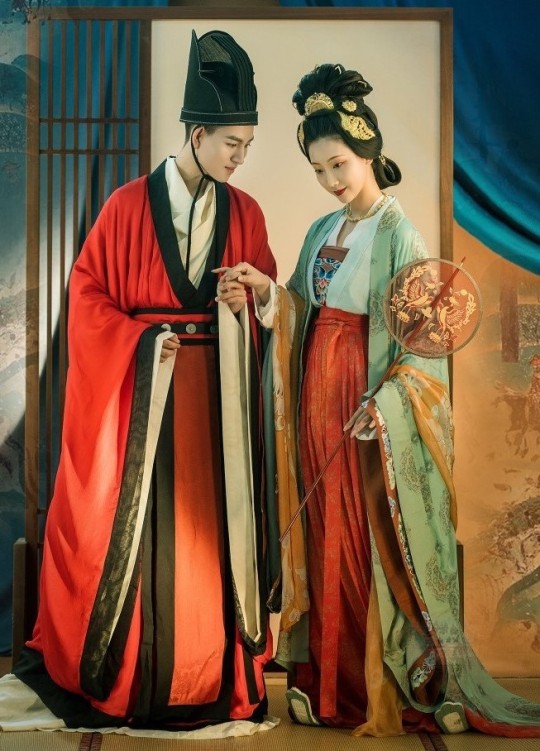
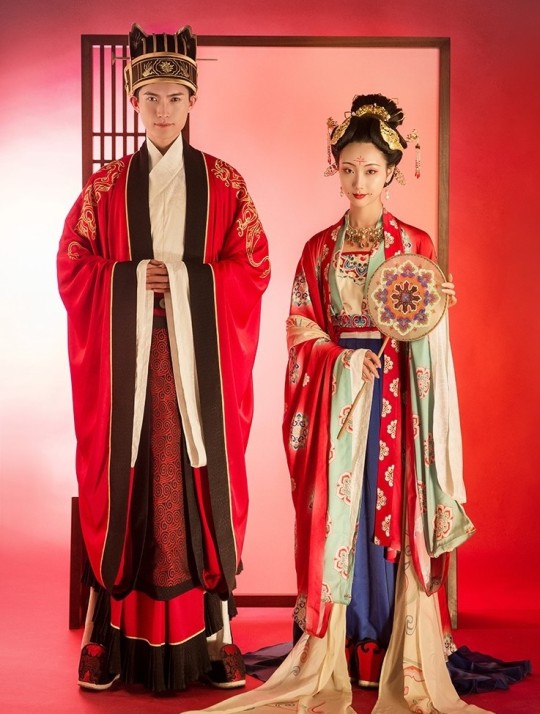
2) Song dynasty wedding hanfu (1, 2) - Note: in past years, modern wedding hanfu came in only three styles - Zhou/Han, Tang, and Ming. It’s only very recently that authentic Song dynasty wedding hanfu has come onto the market. My theory is that it was largely the influence of the 2020 Song dynasty-set Cdrama Serenade of Peaceful Joy, which created a fresh wave of interest in fancy & authentic Song dynasty fashion:

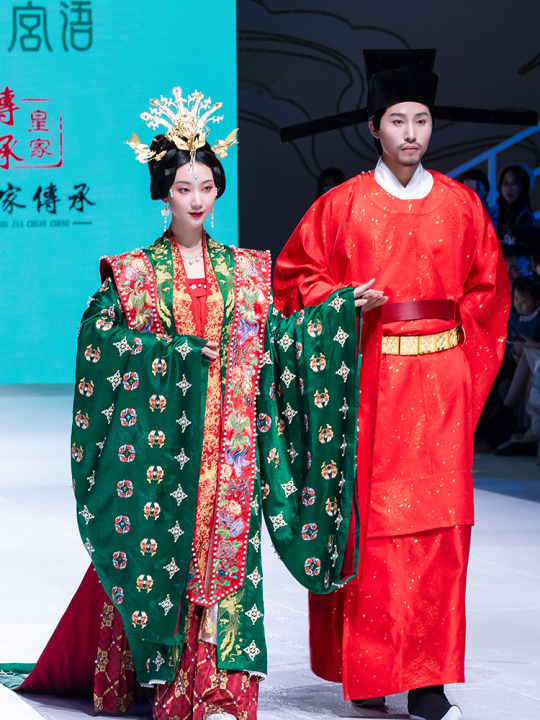
Although the color coordination is the same, Song wedding hanfu differs from Tang wedding hanfu in style & accessories. Here are two easy ways to tell the difference:
Obvious difference #1 - Song wedding hanfu for brides includes a long accessory worn over the shoulders called Xiapei/霞帔. Xiapei was a component of women’s formal clothing during the Song and Ming dynasties, and was therefore a part of Song and Ming wedding hanfu. Xiapei was not a part of Tang wedding hanfu (1, 2):
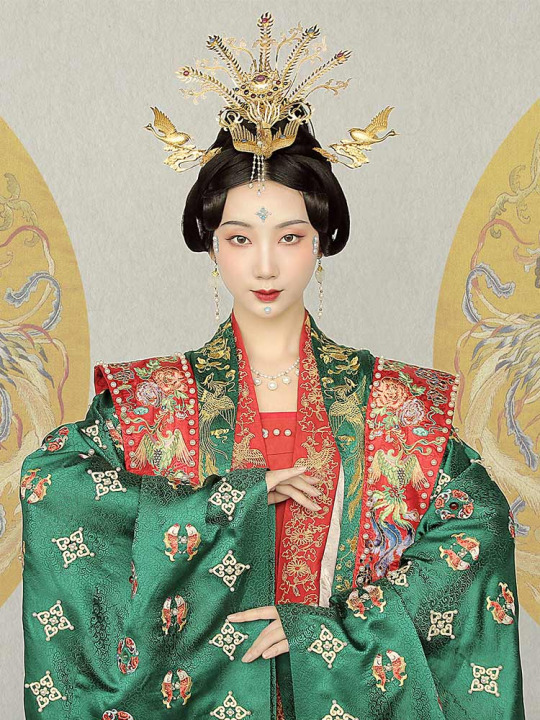
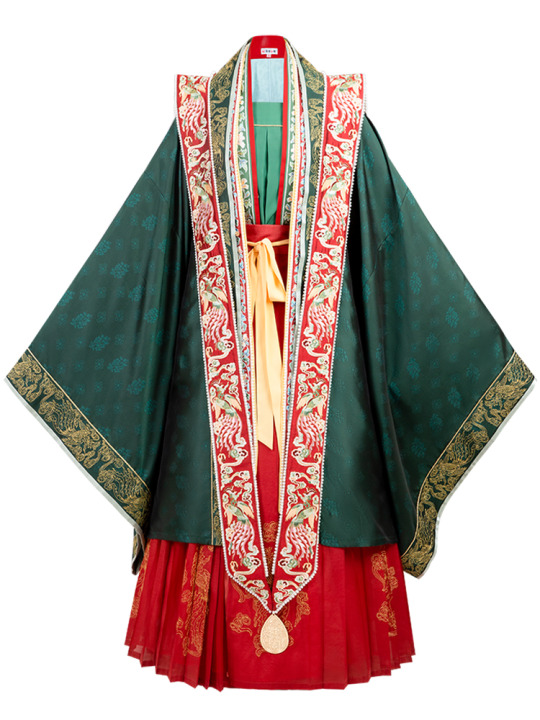
Obvious difference #2 - Men’s headwear is different. Song dynasty grooms wear unique Song official headwear called Zhang Chi Mao/长翅帽 (long winged hat) with long, straight flaps (x):

3) Most Chinese period dramas show the bride and groom wearing all-red wedding hanfu regardless of the time period, but the Song dynasty-set Cdrama The Story of Minglan does a good job showing the traditional red & green wedding colors (x):
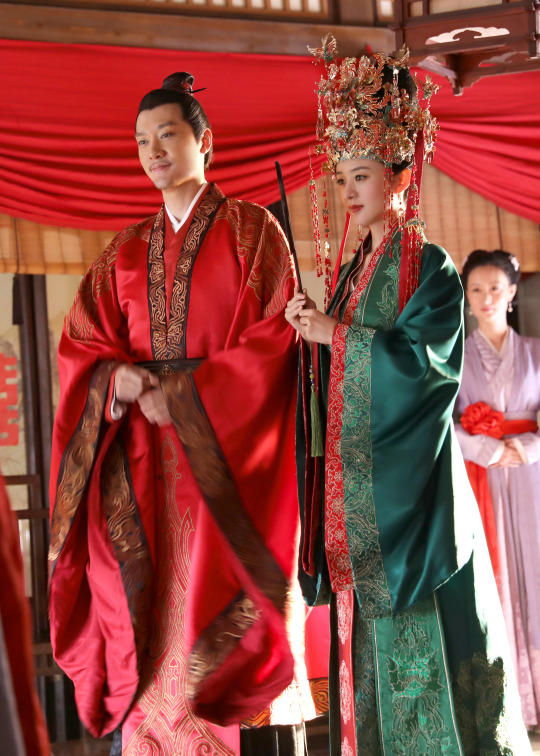
For more visual examples & references, please check out my wedding hanfu tag.
Hope this helps!
#hanfu#wedding hanfu#colors#mens hanfu#xiapei#mens headwear#zhang chi mao#Tang dynasty#Song dynasty#couples hanfu#reference#history#The Story of Minglan#idiom#ask#reply#anon#chinese fashion#chinese culture#china
2K notes
·
View notes
Photo








chinese wedding hanfu by 重回汉唐
372 notes
·
View notes
Photo




song of youth → noble consort sun’s chaofu from episode 2
#song of youth#asiandramanet#cdrama#cdramanet#gifshistorical#weloveperioddrama#perioddramaedit#usersource#tvcentric#chewieblog#dynasty: ming dynasty#stuff:mine#stuff: song of youth#i just love this look and the xiapei#the lighting in this scene is abysmal though#fengguan#costumes: song of youth#costumes: all
125 notes
·
View notes
Video
tumblr
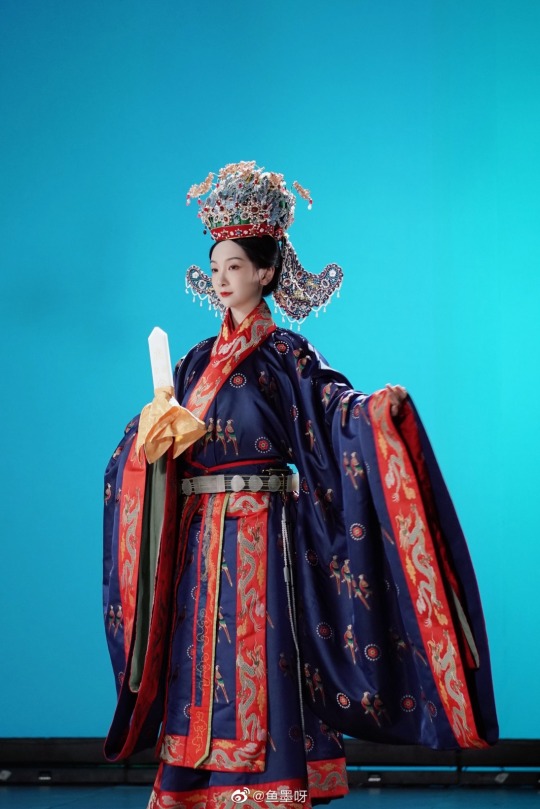
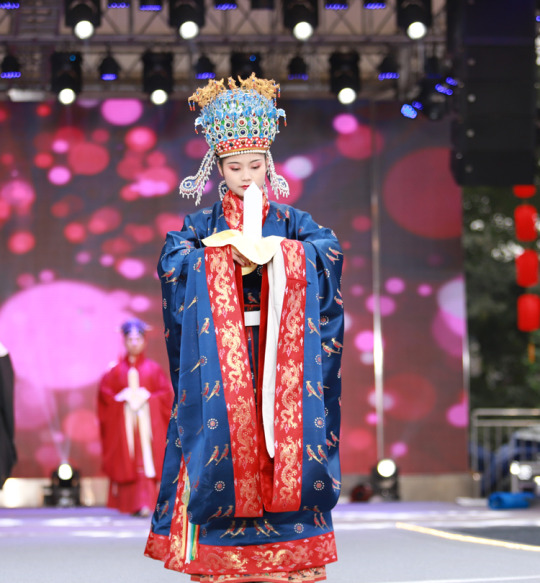

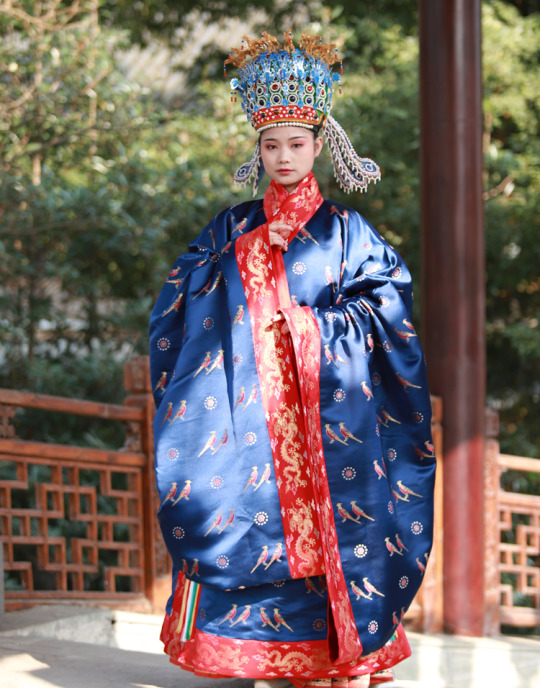
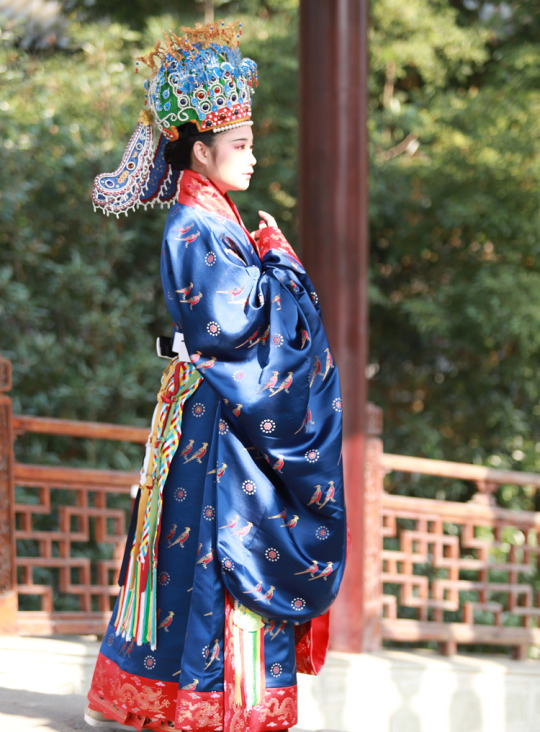
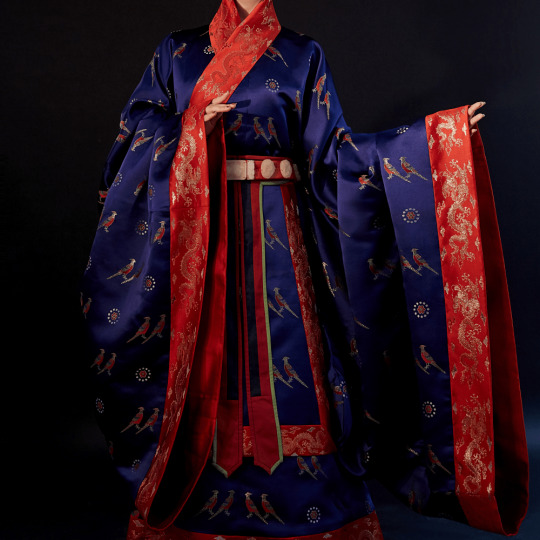

【Historical Artifact Reference】:
Ming Dynasty Royal Portrait:
・Portrait of Empress Xiaoduanxian (Chinese: 孝端顯皇后; 7 November 1564 – 7 May 1620) In ceremonial dress (翟衣/di yi)
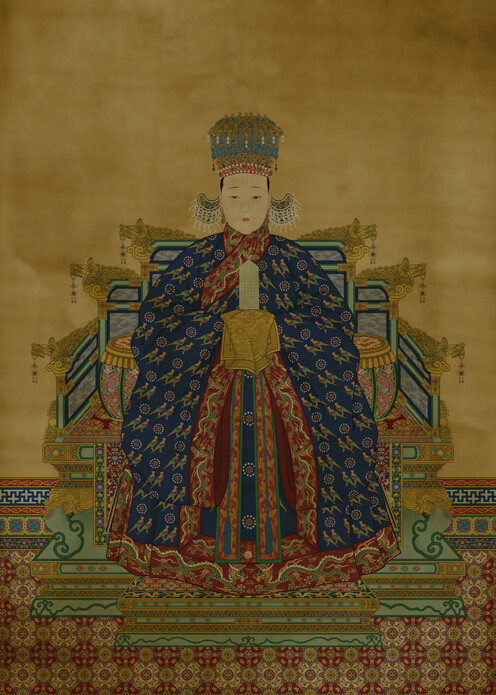
・Nine Dragons and Nine Phoenix Crowns of Empress Xiaoduanxian (※This Phoenix Crowns only for important ceremonial occasion which call “礼冠/Li Guan” wear with ceremonial dress(翟衣/di yi)
----
Unearthed from Ming Dynasty royal mausoleum Ming Dingling (明定陵) , is a mausoleum wehre Wanli Emperor, together with his two empresses Wang Xijie and Dowager Xiaojing, was buried.
In addition to this phoenix crown, the Empress has another phoenix crown for other occasions.
----
Collection of the National Museum of China.
This phoenix crown is 35.5 cm high, 20 cm in diameter, and weighs more than 2,000 grams. It is inlaid with hundreds of high-quality gemstones of various colors and decorated with more than 5,000 fine pearls.



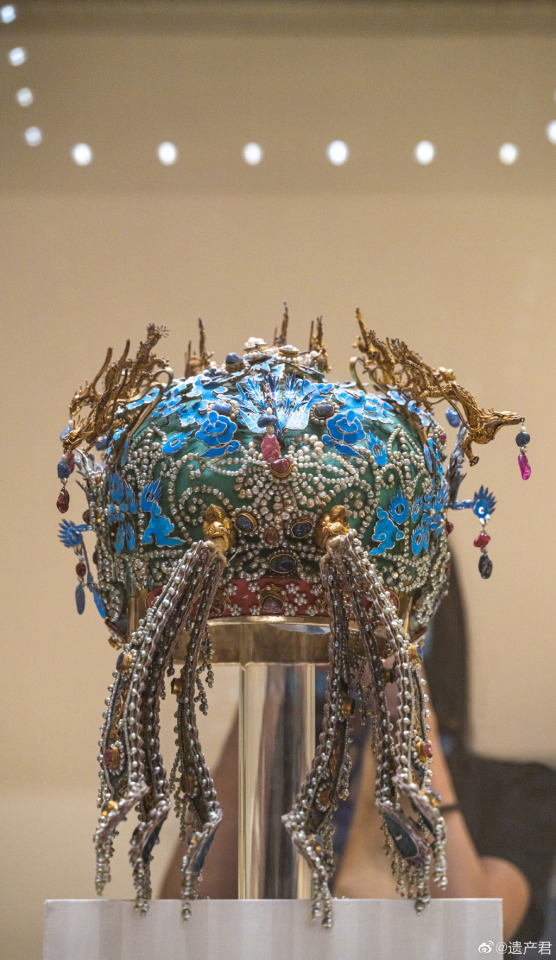
[Hanfu・漢服]Chinese Ming Dynasty Traditional Clothing Hanfu (翟衣) & Phoenix Crown (鳳冠) Reference to Ming Dynasty Relics & Empress Portrait
—–
【History Note】
Diyi (Chinese: 翟衣), also called known as huiyi (褘衣) and miaofu (Chinese: 庙服), is the historical Chinese attire worn by the empresses of the Song dynasty and by the empresses and crown princesses (wife of crown prince) in the Ming Dynasty.
The Diyi also had different names based on its colour, such as yudi, quedi, and weidi. It is a formal wear meant only for ceremonial purposes. It is a form of shenyi (Chinese: 深衣), and is embroidered with long-tail pheasants (Chinese: 翟; pinyin: dí or Chinese: 褘; pinyin: hui) and circular flowers (Chinese: 小輪花; pinyin: xiǎolúnhuā). It is worn with guan known as fengguan (lit. 'phoenix crown') which is typically characterized by the absence of dangling string of pearls by the sides. It was first recorded as Huiyi in the Zhou dynasty(1050–221 BCE).
The Diyi follows the traditional Confucian standard system for dressing, which is embodied in its form through the shenyi(深衣) system. The garment known as shenyi(深衣) is itself the most orthodox style of clothing in traditional Chinese Confucianism; its usage of the concept of five colours, and the use of di-pheasant bird pattern.
【 Influence to Other Country】
Korea
Korean queens started to wear the Diyi (Korean: 적의; Hanja: 翟衣) in 1370 AD under the final years of Gongmin of Goryeo,when Goryeo adopted the official ceremonial attire of the Ming dynasty. Same as the early Korea Joseon, were bestowed by the Ming Dynasty.
According to the Annals of Joseon, from 1403 to the first half of the 17th century the Ming Dynasty sent a letter, which confers the korea queen with a title along with the following items: 翟冠(Ming womens whose husband held the highest government official posts can wear this kind of crown,different from Ming Empress Phoenix Crown 鳳冠), a vest called 褙子(Beizi), and a 霞帔(Xiapei). However, the Diyi sent by the Ming dynasty did not correspond to those worn by the Ming empresses as Joseon was considered to be ranked two ranks lower than Ming.
Instead the Diyi which was bestowed corresponded to the Ming women's whose husband held the highest government official posts. In the early Ming Dynasty period, the Diyi were given to Korea Joseon By Ming, but after the Ming Dynasty reformed the clothing system, The Ming Dynasty bestow the 大衫( Dà shān) to the Korean queen instead of Diyi. The Diyi worn by the Korean queen and crown princess was originally made of red silk; it then became blue in 1897 when the Joseon king and queen were elevated to the status of emperor and empress.
it then became blue in 1897 when the Joseon king and queen were elevated to the status of emperor and empress.
After the fall of the Ming Dynasty, the system of China granting clothing to Korea was interrupted. Korea Joseon were forced to become tributary state of the Qing Dynasty. Korea Joseon carried out "nationalization" based on the costumes bestowed by the Ming Dynasty in the past. But according <Veritable Records of the Joseon Dynasty Volume 46> "嬪宮冊禮時, 旣有翟衣, 則當有翟冠, 而我國匠人不解翟冠之制。 考諸《謄錄》, 則宣廟朝壬寅年嘉禮時, 都監啓以: ‘七翟冠之制, 非但匠人未有解知者, 各樣等物, 必須貿取於中朝, 而終難自本國製造, 何以爲之?’ 云則宣庙有: ‘冠則制造爲難。’ 之敎。 “
Although Korea Joseon has Diyi,but no craftsman know how to make 翟冠(Di Guan), and the materials needed for make 翟冠(Di Guan) need to be taken from China (which need money for that). After all, it is difficult to manufacture in Korea. Therefore, Korea Joseon has not worn 翟冠(Di Guan) since the fall of the Ming Dynasty and change it to 대수머리(大首머리)
Korea "nationalization" process↓
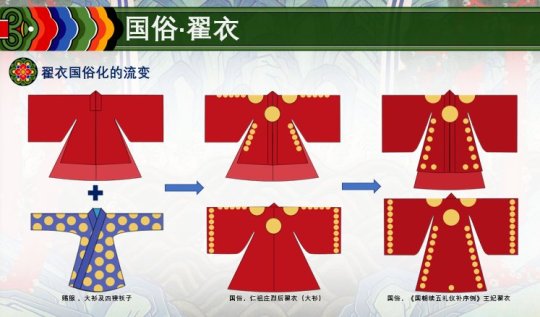
대수머리(大首머리)

Japan
In Japan, the features of the Tang dynasty-style huiyi was found as a textile within the formal attire of the Heian Japanese empresses.
————————
📝Recreation Work & Hanfu: @执月传统服饰 & @鱼墨呀
📸Photo: @执月传统服饰 & @鱼墨呀
🛍️Tabao:https://item.taobao.com/item.htm?spm=a230r.1.14.16.1edc69a6bumOJ8&id=636369495576&ns=1&abbucket=16#detail
🔗Weibo:https://weibo.com/7454398796/K4mehzhsg
————————
#Chinese Hanfu#Ming Dynasty#chinese fashion history#Chinese Culture#Phoenix Crown 鳳冠#Di yi/翟衣#chinese#chinese historical fashion#Empress Xiaoduanxian#Nine Dragons and Nine Phoenix Crowns#Sinosphere#hanfu history#China History
493 notes
·
View notes
Text
Origins of the Pibo: Let’s take a trip along the Silk Road.
1. Introduction to the garment:
Pibo 披帛 refers to a very thin and long shawl worn by women in ancient East Asia approximately between the 5th to 13th centuries CE. Pibo is a modern name and its historical counterpart was pei 帔. But I’ll use pibo as to not confuse it with Ming dynasty’s xiapei 霞帔 and a much shorter shawl worn in ancient times also called pei.
Below is a ceramic representation of the popular pibo.
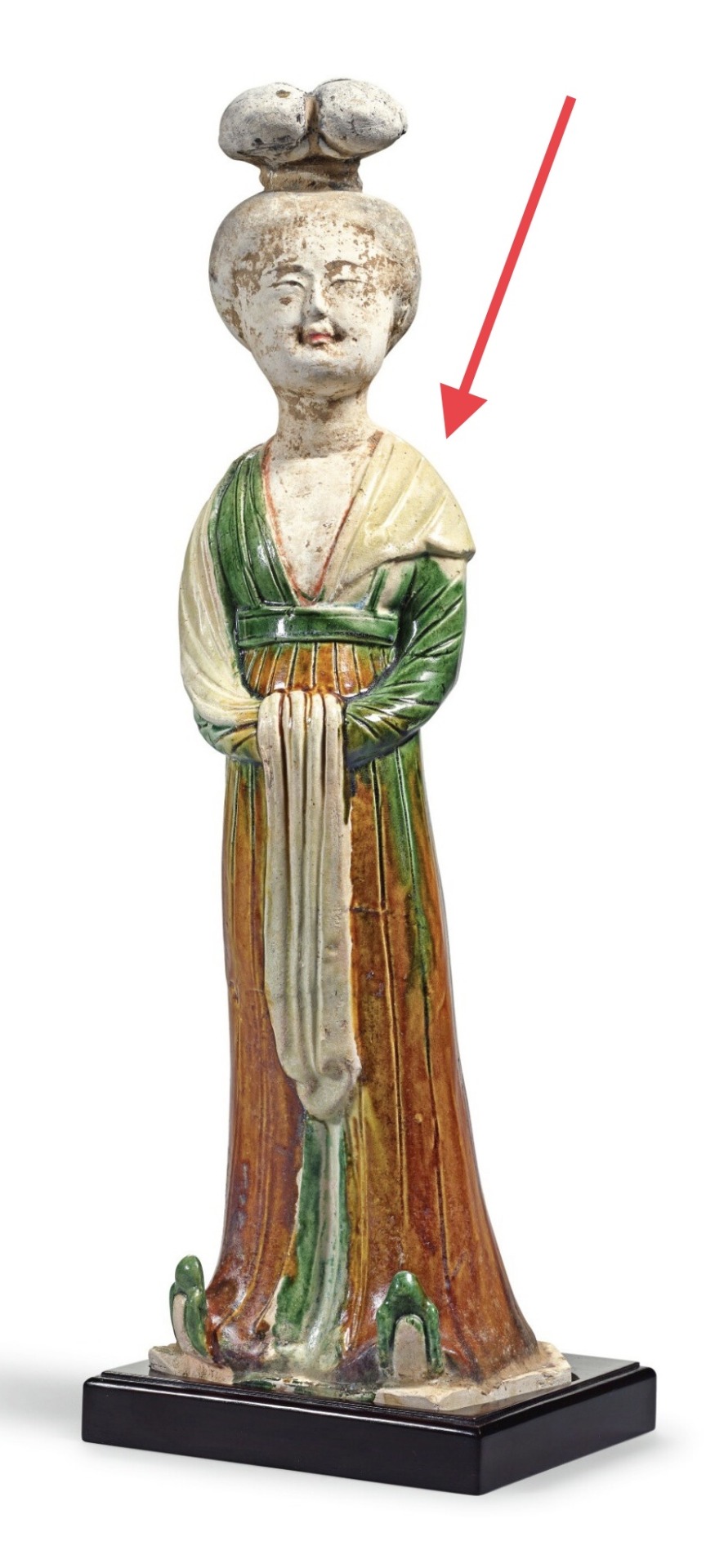
A sancai-glazed figure of a court lady, Tang Dynasty (618–690, 705–907 CE) from the Sze Yuan Tang Collection. Artist unknown. Sotheby’s [image source].
Although some internet sources claim that pibo in China can be traced as far back as the Qin (221-206 BCE) or Han (202 BCE–9 CE; 25–220 CE) dynasties, we don’t start seeing it be depicted as we know it today until the Northern and Southern dynasties period (420-589 CE). This has led to scholars placing pibo’s introduction to East Asia until after Buddhism was introduced in China. Despite the earliest art representations of the long scarf-like shawl coming from the Northern and Southern Dynasties period, the pibo reached its popularity apex in the Tang Dynasty (618–690 CE: 705–907 CE).
Academic consensus: Introduction via the Silk Road.
The definitive academic consensus is that pibo evolved from the dajin 搭巾 (a long and thin scarf) worn by Buddhist icons introduced to China via the Silk Road from West Asia.
披帛是通过丝绸之路传入中国的西亚文化, 与中国服饰发展的内因相结合而流行开来的一种"时世妆" 的形式. 沿丝绸之路所发现的披帛, 反映了丝绸贸易的活跃.
[Trans] Pibo (a long piece of cloth covering the back of the shoulders) was a popular female fashion period accessory introduced to China by West Asian cultures by way of the Silk Road and the development of Chinese costumes. The brocade scarves found along the Silk Road reflect the prosperity of the silk trade that flourished in China's past (Lu & Xu, 2015).
I want to add to the above theory my own speculation that, what the Chinese considered to be dajin, was most likely an ancient Indian garment called uttariya उत्तरीय.
2. Personal conjecture: Uttariya as a tentative origin to pibo.
In India, since Vedic times (1500-500 BCE), we see mentions in records describing women and men wearing a thin scarf-like garment called “uttariya”. It is a precursor of the now famous sari. Although the most famous depiction of uttariya is when it is wrapped around the left arm in a loop, we do have other representations where it is draped over the shoulders and cubital area (reverse of the elbow).
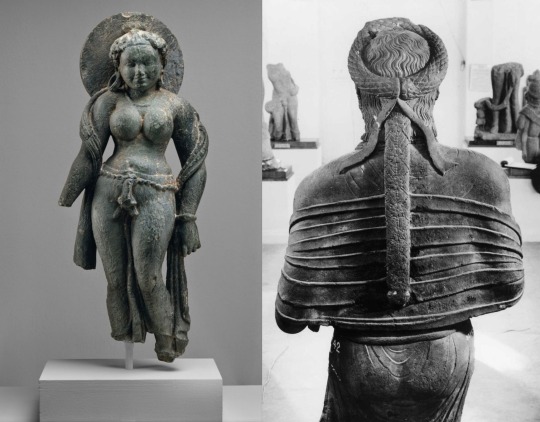
Left: Hindu sculpture “Mother Goddess (Matrika)”, mid 6th century CE, gray schist. Artist unknown. Looted from Rajasthan (Tanesara), India. Photo credit to Metropolitan Museum of Art, New York, United States [image source].
Right: Rear view of female statue possibly representing Kambojika, the Chief Queen of Mahakshatrapa Rajula, ca. 1st century CE. Artist unknown. Found in the Saptarishi Mound, Mathura, India. Government Museum, Mathura [image source].
Buddhism takes many elements from Hindu mythology, including apsaras अप्सरा (water nymphs) and gandharvas गन्धर्व (celestial musicians). The former was translated as feitian 飞天 in China. Hindu deities were depicted wearing clothes similar to what Indian people wore, among which we find uttariya, often portrayed in carvings and sculptures of flying and dancing apsaras or gods to show dynamic movement. Nevertheless, uttariya long predated Buddhism and Hinduism.
Below are carved representation of Indian apsaras and gandharvas. Notice how the uttariya are used.
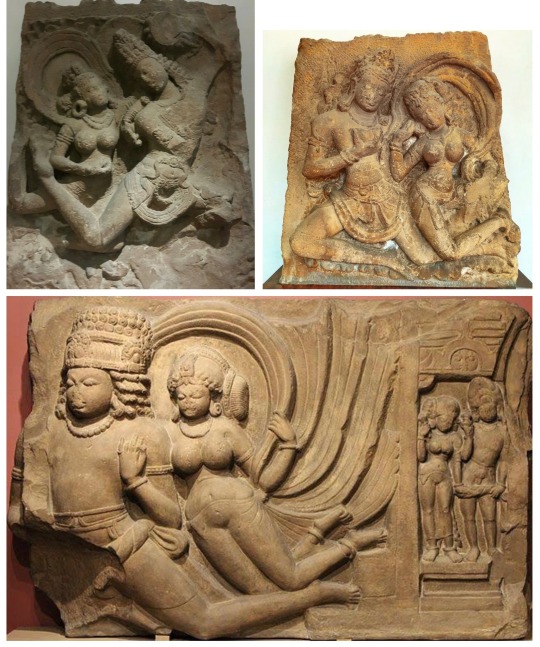
Upper left: Carved relief of flying celestials (Apsara and Gandharva) in the Chalukyan style, 7th century CE, Chalukyan Dynasty (543-753 CE). Artist Unknown. Aihole, Karnataka, India. National Museum, New Delhi, India [image source]. The Chalukyan art style was very influential in early Chinese Buddhist art.
Upper right: Carved relief of flying celestials (gandharvas) from the 10th to the 12th centuries CE. Artist unknown. Karnataka, India. National Museum, New Delhi, India [image source].
Bottom: A Viyadhara (wisdom-holder; demi-god) couple, ca. 525 CE. Artist unknown. Photo taken by Nomu420 on May 10, 2014. Sondani, Mandsaur, India [image source].
Below are some of the earliest representations of flying apsaras found in the Mogao Caves, Gansu Province, China. An important pilgrimage site along the Silk Road where East and West met.
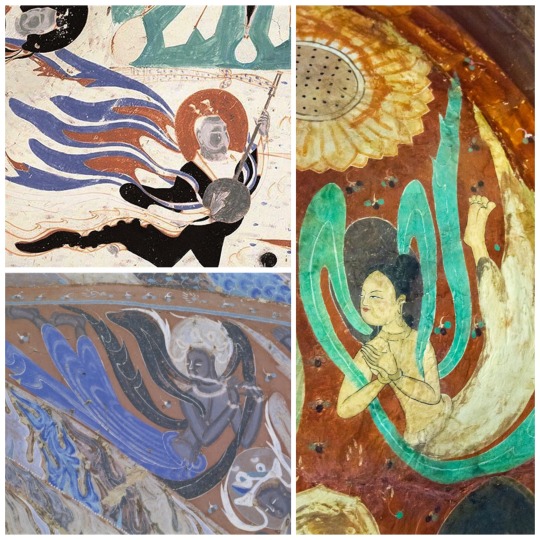
Left to right: Cave No. 461, detail of mural in the roof of the cave depicting either a flying apsara or a celestial musician. Western Wei dynasty (535–556 CE). Artist unknown. Mogao Grottoes, Dunhuang, China [image source].
Cave 285 flying apsara (feitian) in one of the Mogao Caves. Western Wei Dynasty (535–556 CE), Artist unknown. Photo taken by Keren Su for Getty Images. Mogao Grottoes, Dunhuang, China [image source].
Cave 249. Mural painting of feitian playing a flute, Western Wei Dynasty (535-556 CE). Image courtesy by Wang Kefen from The Complete Collection of Dunhuang Grottoes, Vol. 17, Paintings of Dance, The Commercial Press, Hong Kong, 2001, p. 15. Mogao Grottoes, Dunhuang, China [image source].
I theorize that it is likely that the pibo was introduced to China via Buddhism and Buddhist iconography that depicted apsaras (feitian) and other deites wearing uttariya and translated it to dajin.
3. Trickle down fashion: Buddhism’s journey to the East.
However, since Buddhism and its Indian-based fashion spread to West Asia first, to Sassanian Persians and Sogdians, it is likely that, by the time it reached the Han Chinese in the first century CE, it came with Persian and Sogdian influence. Persians’ fashion during the Sassanian Empire (224–651 CE) was influenced by Greeks (hellenization) who also had a a thin long scarf-like garment called an epliblema ἐπίβλημα, often depicted in amphora (vases) of Greek theater scenes and sculptures of deities.
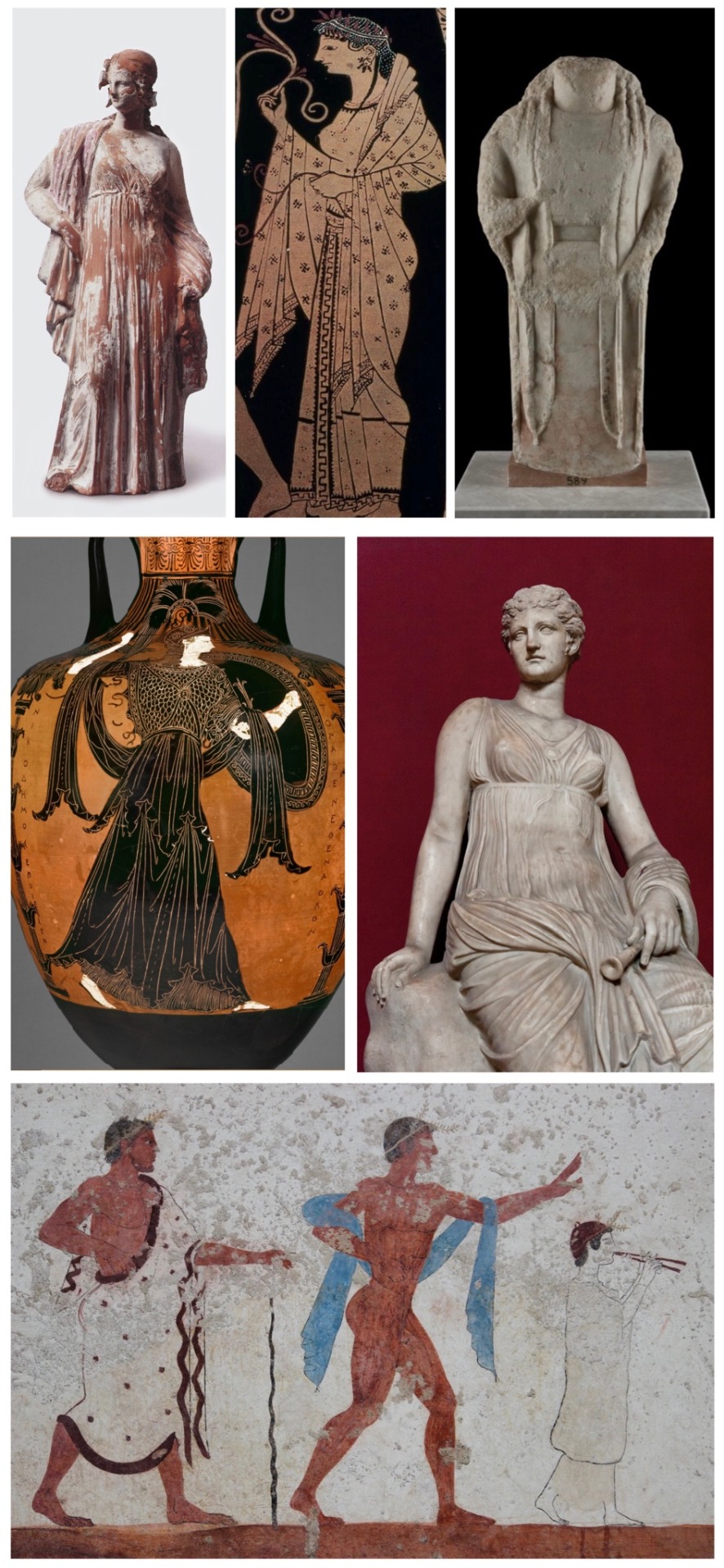
Left to right: Dame Baillehache from Attica, Greece. 3rd century BCE, Hellenistic period (323-30 BCE), terracotta statuette. Photo taken by Hervé Lewandowski. Louvre Museum, Paris, France [image source].
Deatail view of amphora depicting the goddess Artemis by Athenian vase painter, Andokides, ca. 525 BCE, terracotta. Found in Vulci, Italy. Altes Museum, Berlin, Germany [image source].
Statue of a Kore (young girl), ca. 570 BCE, Archaic Period (700-480 BCE), marble. Artist unknown. Uncovered from Attica, Greece. Acropolis Museum, Athens, Greece [image source].
Detail view of Panathenaic (Olympic Games) prize amphora with lid, 363–362 BCE, Attributed to the Painter of the Wedding Procession and signed by Nikodemos, terracotta. Uncovered from Athens, Greece. J. Paul Getty Museum, Los Angeles, California, United States [image source].
Roman statue depicting Euterpe, muse of lyric poetry and music, ca. 2nd century CE, marble, Artist unknown. From the Villa of G. Cassius Longinus near Tivoli, Italy. Photo taken by Egisto Sani on March 12, 2012, Vatican Museums, Rome, Italy [image source].
Greek (or Italic) tomb mural painting from the Tomb of the Diver, ca. 470 BCE, fresco. Artist unknown. Photo taken by Floriano Rescigno. Necropolis of Paestum, Italy [image source].
Below are Iranian and Iraqi period representations of this long thin scarf.

Left to right: Closeup of ewer likely depicting a female dancer from the Sasanian Period (224–651 CE) in ancient Persia , Iran, 6th-7th century CE, silver and gilt. Artist unknown. Mary Harrsch. July 10, 2015. Arthur M. Sackler Gallery of Asian Art, Smithsonian, Washington D.C [image source].
Ewer with nude dancer probably representing a maenad, companion of Dionysus from the Sasanian Period (224–651 CE) in ancient Persia, Iran, 6th-7th century CE, silver and gilt. Artist unknown. Mary Harrsch. July 16, 2015. Arthur M. Sackler Gallery of Asian Art, Smithsonian, Washington D.C [image source].
Painting reconstructing the image of unveiled female dancers depicted in a fresco, Early Abbasid period (750-1258 CE), about 836-839 CE from Jawsaq al-Khaqani, Samarra, Iraq. Museum of Turkish and Islamic Art, Istanbul [image source].
The earliest depictions of Buddha in China, were very similar to West Asian depictions. Ever wonder why Buddha wears a long draped robe similar to a Greek himation (Romans called it toga)?
Take a look below at how much the Greeks influenced the Kushans in their art and fashion. The top left image is one of the earliest depictions of Buddha in China. Note the similarities between it and the Gandhara Buddha on the right.
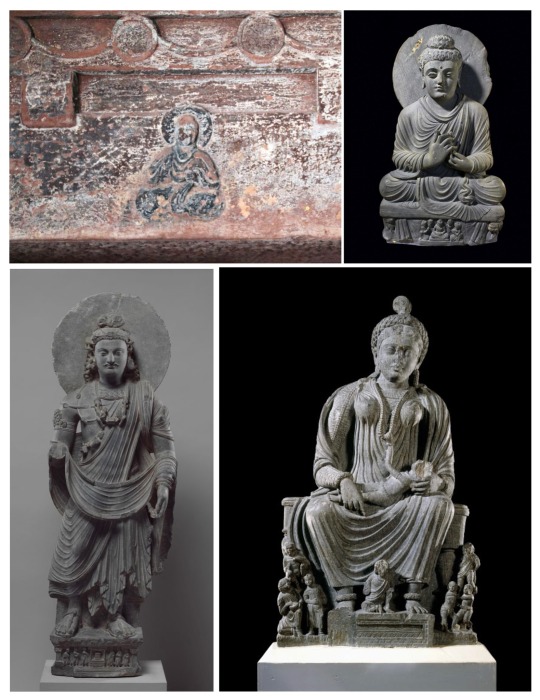
Left: Seated Buddha, Mahao Cliff Tomb, Sichuan Province, Eastern Han Dynasty, late 2nd century C.E. (photo: Gary Todd, CC0).
Right: Seated Buddha from Gandhara, Pakistan c. 2nd–3rd century C.E., Gandhara, schist (© Trustees of the British Museum)
Standing Bodhisattva Maitreya (Buddha of the Future), ca. 3rd century, gray schist. From Gandhara, Pakistan. Image credit to The Metropolitan Museum of Art, New York City, United States [image source].
Statue of seated goddess Hariti with children, ca. 2nd to 3rd centuries CE, schist. Artist unknown. From Gandhara, Pakistan. The British Museum, London, England [image source].
Before Buddhism spread outside of Northern India (birthplace), Indians never portrayed Buddha in human form.
Early Buddhist art is aniconic, meaning the Buddha is not represented in human form. Instead, Buddha is represented using symbols, such as the Bodhi tree (where he attained enlightenment), a wheel (symbolic of Dharma or the Wheel of Law), and a parasol (symbolic of the Buddha’s royal background), just to name a few. […] One of the earliest images [of Buddha in China] is a carving of a seated Buddha wearing a Gandharan-style robe discovered in a tomb dated to the late 2nd century C.E. (Eastern Han) in Sichuan province. Ancient Gandhara (located in present-day Afghanistan, Pakistan, and northwest India) was a major center for the production of Buddhist sculpture under Kushan patronage. The Kushans occupied portions of present-day Afghanistan, Pakistan, and North India from the 1st through the 3rd centuries and were the first to depict the Buddha in human form. Gandharan sculpture combined local Greco-Roman styles with Indian and steppe influences (Chaffin, 2022).
In the Mogao Caves, which contain some of the earliest Buddhist mural paintings in China, we see how initial Chinese Buddhist art depicted Indian fashion as opposed to the later hanfu-inspired garments.
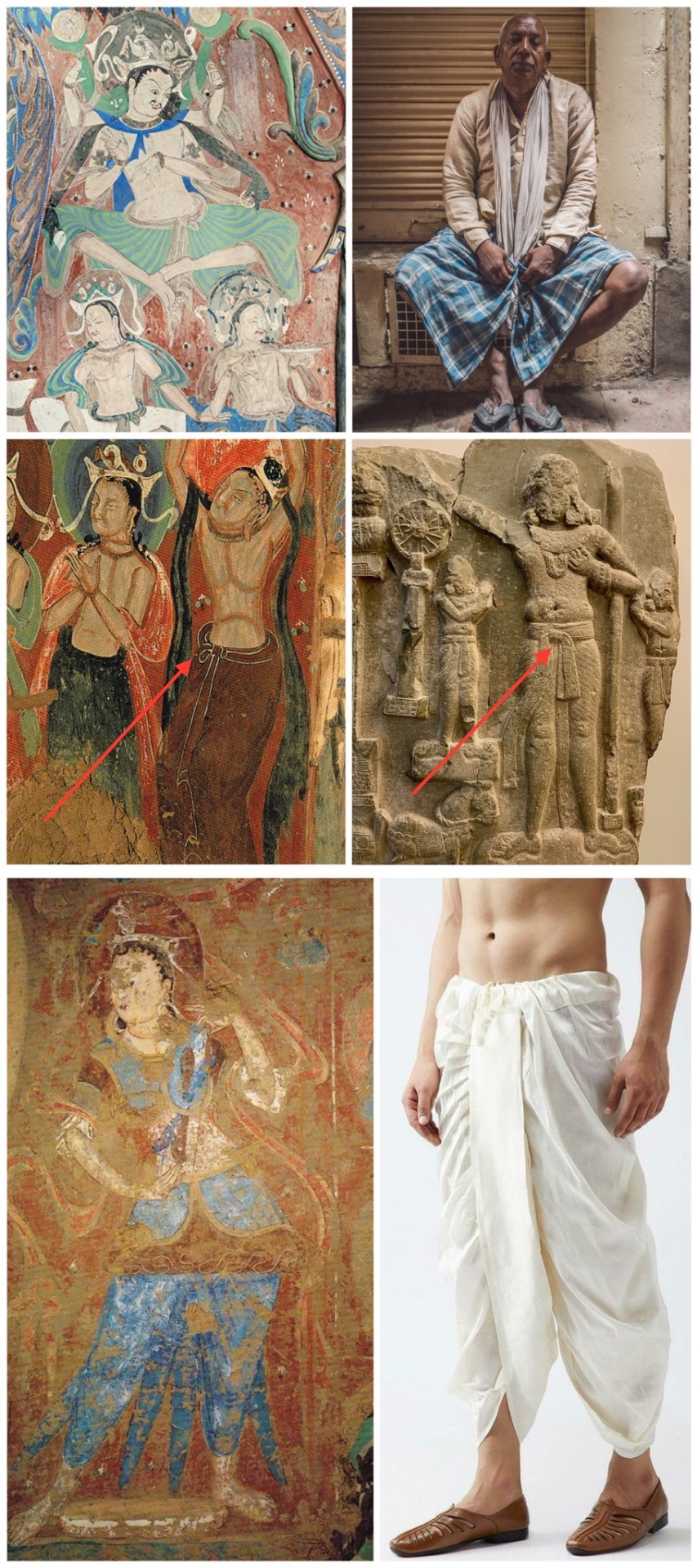
Left to right: Cave 285, detail of wall painting, Western Wei dynasty (535–556 CE). Mogao Grottoes, Dunhuang, China. Courtesy the Dunhuang Academy [image source]. Note the clothes the man is wearing. It looks very similar to a lungi (a long men’s skirt).
Photo of Indian man sitting next to closed store wearing shirt, scarf, lungi and slippers. Paul Prescott. February 20, 2015. Varanasi, India [image source].
Cave 285, mural depiction of worshipping bodhisattvas, 6th century CE, Wei Dynasty (535-556 A.D.), Unknown artist. Mogao Grottoes, Dunhuang, China. Notice the half bow on his hips. That is a common style of tying patka (also known as pataka; cloth sashes) that we see throughout Indian history. Many of early Chinese Buddhist paintings feature it, including the ones at Mogao Caves.
Indian relief of Ashoka wearing dhoti and patka, ca. 1st century BC, Unknown artist. From the Amaravathi village, Guntur district, Andhra Pradesh, India. Currently at the Guimet Museum, Paris [image source].
Cave 263. Mural showing underlying painting, Northern Wei Dynasty (386–535 CE). Artist Unknown. Picture taken November 29, 2011, Mogao Grottoes, Dunhuang, China [image source]. Note the pants that look to be dhoti.
Comparison photo of modern dhoti advertisement from Etsy [image source].
Spread of Buddhism to East Asia.

Map depicting the spread of Buddhism from Northern India to the rest of Asia. Gunawan Kartapranata. January 31, 2014 [image source]. Note how Mahayana Buddhism arrived to China after passing through Kushan, Bactrean, and nomadic steppe lands, absorbing elements of each culture along the way.
Wealthy Buddhist female patrons emulated the fantasy fashion worn by apsaras, specifically, the uttariya/dajin and adopted it as an everyday component of their fashion.
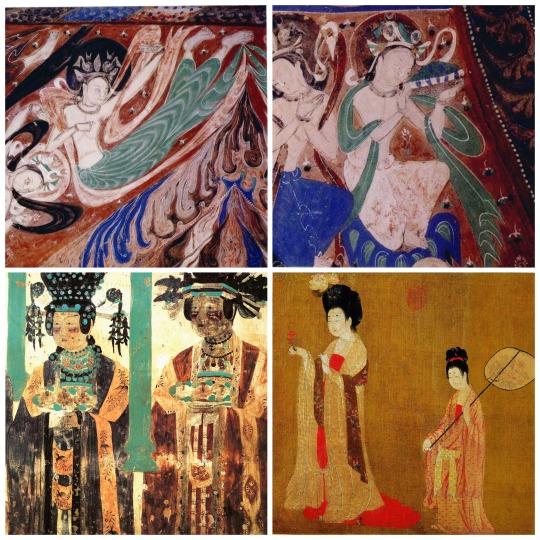
Cave 285. feitian mural painting on the west wall, Western Wei Dynasty (535–556 CE). Artist unknown. Mogao Grottoes, Dunhuang, China [image source].
Cave 285. Detail view of offering bodhisattvas (bodhisattvas making offers to Buddha) next to the phoenix chariot on the Western wall of the cave. Western Wei Dynasty (535–556 CE). Artist unknown. Mogao Grottoes, Dunhuang, China [image source].
Cave 61 Khotanese (from the kingdom of Khotan 于阗 [56–1006 CE]) donor ladies, ca. 10th century CE, Five Dynasties period (907 to 979 CE). Artist unknown. Picture scanned from Zhang Weiwen’s Les oeuvres remarquables de l'art de Dunhuang, 2007, p. 128. Uploaded to Wikimedia Commons on October 11, 2012 by Ismoon. Mogao Grottoes, Dunhuang, China [image source].
Detail view of Ladies Adorning Their Hair with Flowers 簪花仕女图, late 8th to early 9th century CE, handscroll, ink and color on silk, Zhou Fang 周昉 (730-800 AD). Liaoning Provincial Museum, Shenyang, China [image source].
Therefore, the theory I propose of how the pibo entered East Asia is:
India —> Greek influenced West Asia (Sassanian Persians, Sogdians, Kushans, etc…) —> Han China —> Rest of East Asia (Three Kingdoms Korea, Asuka Japan, etc…)
Thus, the most likely theory, in my person opinion, is Buddhist iconography depicting uttariya encountered Greek-influenced West Asian Persian, Sogdian, and Kushan shawls, which combined arrived to China but wouldn’t become commonplace there until the explosion in popularity of Buddhism from the periods of Northern and Southern Dynasties to Song.
References:
盧秀文; 徐會貞. 《披帛與��路文化交流》 [The brocade scarf and the cultural exchanges along the Silk Road]. 敦煌研究 (中國: 敦煌研究編輯部). 2015-06: 22 – 29. ISSN 1000-4106.
#hanfu#chinese culture#chinese history#buddhism#persian#sogdian#kushan#gandhara#indian fashion#uttariya#pibo#history#asian culture#asian art#asian history#asian fashion#east asia#south asia#india#pakistan#iraq#afghanistan#sassanian#silk road#fashion history#tang dynasty#eastern han dynasty#cultural exchange#greek fashion#mogao caves
302 notes
·
View notes
Text
China Masterlist 🏮
Umbrella Terms
Guofeng
Huafu (any clothing originating in China)
Hanfu (Han-Chinese ethnic clothing)
Hanyuansu (western clothing inspired by hanfu)
Modified Hanfu
Wedding Hanfu
Winter Hanfu
~~
General Hanfu Terms
Men’s Hanfu
Mianfu (emperor’s clothes)
Dachang (male equivalent of a pifeng)
Yichang (men's top + skirt)
Yuanlingpao
Qiyao Ruqun (Parallel Collar) (Crossed Collar)
Moxiong (undergarment for women)
Shan
~~
Han Dynasty + Wei/Jin Dynasties
Danyi (sheer coat for shenyi)
Shenyi
Zhiju (straight-hem robe)
Quju (curved-hem robe)
~~
Tang Dynasty
Daxiushan (lit. big sleeved shirt/robe)
Banbi (Tang Dynasty half sleeve jacket)
Banxiu
Tanling (U-collared shirt)
Qixiong Ruqun (chest-high ruqun)
Yaoqun
Heiziqun
Hezi
~~
Song Dynasty
Beizi (narrow-sleeved coat with slits on the side)
Beixin
Moxiu
Lanshan
Xiapei
Baidiequn
Song-style Pants
~~
Ming Dynasty
Pifeng (big sleeved coat)
Bijia (sleeveless version of a pifeng)
Zhaojia (male equivalent of a bijia)
Changshan
Zhuyao
Mamianqun (horse-faced skirt)
Aoqun (Ming Dynasty top + skirt)
Zhiduo
Daopao
Tieli (pleats go around the skirt)
Yesa (no pleats at the front of the skirt)
Fengguan (phoenix crown)
Yunjian (shoulder accessory)
~~
Qing Dynasty
Qizhuang (Manchurian ethnic clothing)
Qinghannǚ (Han women's clothes of the Qing Dynasty)
Liangbatou (hairstyle)
Dalachi (hairstyle)
~~
Republican Era/Minguo
Qipao/Cheongsam
~~
Footwear
Zaoxue
Chixi
Fangxi
Qitoulv
Qiaotoulv
Yuntoujinlv
Tang-Style Astana Cemetery Raised Head Shoes
Tang-Style Astana Cemetery Shoes
Fanglv
Gongxie
Dengyunlv
Yunwa (socks)
~~
Makeup
Pearl Makeup
Huadian (forehead)
Xiehong (side of face)
Mianye (dimples)
~~
Musical Instruments
Guzheng
Pipa
Yueqin
Guqin
Dizi
~~
Other Clothing Tags
Guzhuang
Qi Lolita
Qungua
Xiuhefu
Xiyu
~~
Other Tags
Chinese Opera
Beijing Opera
C-Drama
Gufeng
136 notes
·
View notes